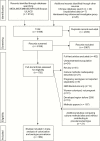Maternal Colonization With Group B Streptococcus and Serotype Distribution Worldwide: Systematic Review and Meta-analyses
- PMID: 29117327
- PMCID: PMC5848259
- DOI: 10.1093/cid/cix658
Maternal Colonization With Group B Streptococcus and Serotype Distribution Worldwide: Systematic Review and Meta-analyses
Abstract
Background: Maternal rectovaginal colonization with group B Streptococcus (GBS) is the most common pathway for GBS disease in mother, fetus, and newborn. This article, the second in a series estimating the burden of GBS, aims to determine the prevalence and serotype distribution of GBS colonizing pregnant women worldwide.
Methods: We conducted systematic literature reviews (PubMed/Medline, Embase, Latin American and Caribbean Health Sciences Literature [LILACS], World Health Organization Library Information System [WHOLIS], and Scopus), organized Chinese language searches, and sought unpublished data from investigator groups. We applied broad inclusion criteria to maximize data inputs, particularly from low- and middle-income contexts, and then applied new meta-analyses to adjust for studies with less-sensitive sampling and laboratory techniques. We undertook meta-analyses to derive pooled estimates of maternal GBS colonization prevalence at national and regional levels.
Results: The dataset regarding colonization included 390 articles, 85 countries, and a total of 299924 pregnant women. Our adjusted estimate for maternal GBS colonization worldwide was 18% (95% confidence interval [CI], 17%-19%), with regional variation (11%-35%), and lower prevalence in Southern Asia (12.5% [95% CI, 10%-15%]) and Eastern Asia (11% [95% CI, 10%-12%]). Bacterial serotypes I-V account for 98% of identified colonizing GBS isolates worldwide. Serotype III, associated with invasive disease, accounts for 25% (95% CI, 23%-28%), but is less frequent in some South American and Asian countries. Serotypes VI-IX are more common in Asia.
Conclusions: GBS colonizes pregnant women worldwide, but prevalence and serotype distribution vary, even after adjusting for laboratory methods. Lower GBS maternal colonization prevalence, with less serotype III, may help to explain lower GBS disease incidence in regions such as Asia. High prevalence worldwide, and more serotype data, are relevant to prevention efforts.
Keywords: colonization; group B Streptococcus; pregnancy; serotypes; vaginal.
© The Author 2017. Published by Oxford University Press for the Infectious Diseases Society of America.
Figures





References
-
- Melin P, Efstratiou A. Group B streptococcal epidemiology and vaccine needs in developed countries. Vaccine 2013; 31(suppl 4):D31–42. - PubMed
-
- Le Doare K, Heath PT. An overview of global GBS epidemiology. Vaccine 2013; 31(suppl 4):D7–12. - PubMed
-
- Kwatra G, Cunnington MC, Merrall E et al. . Prevalence of maternal colonisation with group B Streptococcus: a systematic review and meta-analysis. Lancet Infect Dis 2016; 16:1076–84. - PubMed
Publication types
MeSH terms
Grants and funding
LinkOut - more resources
Full Text Sources
Other Literature Sources
Medical

